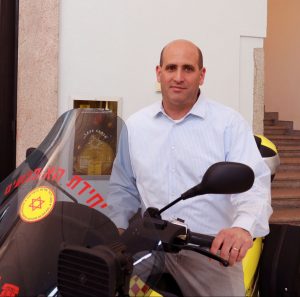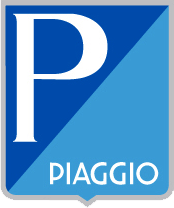How to obtain a Quicker Response Time? Israeli Solution is Motorbike Ambulance
Aug 1, 2019
How vital is quickness in case of emergency? In some congested areas, conventional ambulances do not fit very well to provide emergency care for many reasons. So, how to obtain a quicker response time? Magen David Adom has tested for years a solution based on the Piaggio Mp3 500, and it works very well.
Is there any way to cut ambulance intervention response?
In Israel, the Magen David Adom thinks so. But who is the Magen David Adom? MDA is an international NGO that exists for 120 years. It is a member of the International Federation of Red Cross and Red Crescent Societies, and many of the components of the association are volunteers. In Israel, they have the mandate of providing the pre-hospital services to all the citizens in the Country by managing the EMS number 101. The task of MDA in Israel is really simple: give the proper medical response to all the patients who are in need throughout the Israeli territory, in the best way they can and as fast as possible. MDA is also in charge to manage the national blood bank.
“Magen David Adom is everywhere in Israel,” said the CFO of the Magen David Adom, Mr Alon Fridman. “The main core of our activity is EMS services, that we are doing through 130 stations over the country, using 1300 ambulances (mike and regular) and more than 500 motorbikes”.
How MDA can reach a patient in approximately 4 minutes in the urban areas?
“We have a fast reaction to the emergency calls thanks to the very high-tech system we have implemented during the last years. We get a call through a computer system that can localize the event immediately. Nowadays, the localization is highly reliable, and it has crossed with all our fleet GPS positions. So, we know exactly where each vehicle is, and we know where the patient is, either.
Alon Fridman, CFO della Magen David Adom

Why choosing a motorbike service to provide a basic first response with BLSD volunteers? Magen David Adom test form years a solution based on the Piaggio MP3 500. They are also testing it as Advanced Life Support medical response bike with paramedics, on duty to anticipate ambulance and giving a better response to code 3 patients.
With this information, the computer sends to the target the closest car. But our system stages were created 6 or 7 years ago, and one of them is the first responding unit. It is a voluntary body made by 25.000 volunteers from 15 to 80 years old. All of them have been BLSD trained, and we give them all the necessary equipment to operate in the proper way on the scene.
Some volunteers are using their own cars to work, but we furnished BLSD equipped Piaggio Mp3 500 motorbikes to 500 first responders. The main goal of this team is to get as quickly as possible to the scene. Volunteers are located in the most crowded towns of Israel, like Tel-Aviv, Jerusalem and Haifa. We know that a traditional ambulance will take too much time to reach the scene because of traffic jams or other issues. With this type of motorbike, we can send a BLSD trained responder to the target in 4 minutes, and he can treat the patient – giving the first support and stabilization. When the ambulance arrives on the scene, the medical unit will continue treatments up to the hospital”.
How to obtain a Quicker Response Time? Israeli Solution is Motorbike Ambulance
When did you start using first responders and motorbikes?
“It is a crucial point for us having a group of first responders. We just now have a State Review on our activity, and we get a very high score because of this specific group and the way we are working with the motorbike. We were starting using bikes since 2010 using different types of motorcycles. When we discovered Piaggio Mp3, we thought it was good for us for many reasons. First of all, it is a three-wheeled motorbike. It is much safer than other motorcycles for our first responders. Our team members report us that they are confident about riding the Mp3.
The second reason why we have selected those bikes is that we can equip them with all the medical devices we need to operate on the streets. Defibrillators, BLS bag, bleeding control system, oxygen, suction unit: all the crucial medical tools you need to arrive at the scene is on the bike, and you can start immediately stabilizing the patient. These motorbikes also have lights and sirens to show better their presence and reach the scene quickly, safe and sound! But it is still not enough for us.
Cutting intervention time to the half is not enough? What are you studying?
We are trying all the time to see how to manage more interventions, to create better services, giving a better response to patients. Now we are testing an innovative solution. We took out some of our ambulances to the regular shift, and we integrated some of our motorbikes. We want to see if motorcycles can improve the arrival time and the response average also with ALS professionals during the same shift. We want to know if putting motorbikes at work and send them directly can reduce the reaction time. Currently, we are highly satisfied with this solution”.
What kind of professional will ride the motorcycle ambulance?
“The motorbike ambulance is led – in this case – by a paramedic. They have specific ALS equipment. We send the bike with a paramedic in specific scenarios, where we need to have a fast advanced response. When we know that there is an intervention where the paramedic can improve the medical response, we use the bike. We are pleased with this solution, and we intend to underline it with the data we are collecting, especially in case of OHCA or mass casualties, when the reduction of intervention time is a significant and positive outcome. If a bus accident occurs on a highway, for example, traffic jam is a big problem, and sometimes, sending first responders to the scene is not enough. We use motorbikes with paramedics also because we need someone who reports us the situation. We need to know better how many resources we have to send on site. The motorbike is not only the fastest response we have but also a good “eye” to see what we require to do with our resources regarding the intervention”.
Is there also space to place a camera?
“Yes! We have motorbikes with cameras, especially on the first responders’ bikes. All of our vehicles were equipped with that device. It is a part of our reporting system. The dispatch centre controls the camera, and when an ambulance – or better, a motorbike – arrives on site and remains between 10 or 15 meters, the paramedic acts and treats the patient, while the dispatcher can operate in remote thanks to the camera, watching the scene, deciding what kind of resource send to it, and who can also be useful for the intervention”.






